Elder Voices Project
Just letting you know about a submission opportunity for Whatcom County poets and writers. The workshops (notice mine is TOMORROW!) are open to all ages. Registration is NOT required, and the workshops are free to all.
Just letting you know about a submission opportunity for Whatcom County poets and writers. The workshops (notice mine is TOMORROW!) are open to all ages. Registration is NOT required, and the workshops are free to all.
Alternate title: the writer with children. This started out as one sort of reflection, and turned into another.
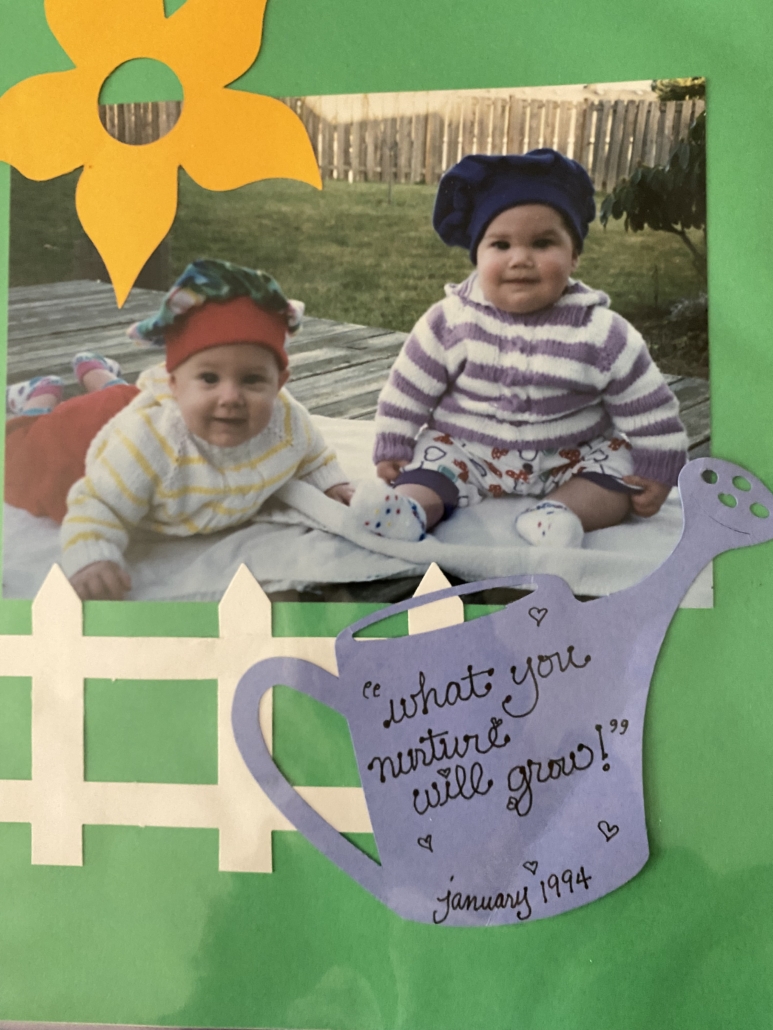 My older two daughters turn 31 today, which I find completely unbelievable. Their baby sister turns 25 in 10 days.
My older two daughters turn 31 today, which I find completely unbelievable. Their baby sister turns 25 in 10 days.
I was never a young mom. I was 37 when we adopted Annie and Pearl, and 43 when Emma came along.
Thinking about it, I’ve always been a late bloomer. Which is why, at age 37, I was in graduate school, post-classes, pre-exams. I was also teaching one class each quarter, which paid my tuition and a stipend.
Maybe my friends should have warned me that I’d lost my mind. Instead everyone was astonished and supportive. I’m immensely grateful.
But I did kind of lose my mind, or at least my way. I spent the first six months avoiding my graduate work and being a crap teacher, too. I got away with it for a while, until I didn’t. One memorable (ugh) quarter, I was so wrung out and sleep-deprived that I had the absolute worst student evaluations of my life. It was humiliating. I wanted to hide under a rock until it all went away.
Instead, because of that class, I completely overhauled my strategy. Or strategies. Because of the brutal honesty of those students, I learned to be all in when I was prepping for teaching, when reading their papers, and — especially — while in the classroom or in conference with them.
Much of the time, I was all in with my daughters, too. Some of my best memories are of lying on the floor with them while they played, taking them for walks, blowing bubbles on the front porch, reading books. Going to see their grandparents. In time, I figured out how to do a version of parallel play, and while they were busy doing their thing, I veered off into my own books.
Because of my daughters, I completely restructured my Ph.D. I chose advisors who were parents (two of them 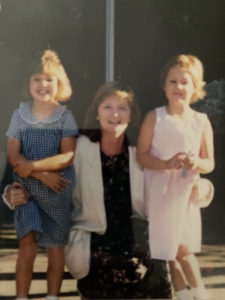 women who had children while in graduate school). I was in 19th century American literature studies; the centerpiece of my dissertation was Nathaniel Hawthorne, but other chapters included two women authors who remained childless, a woman author who abandoned her children, and a woman author whose only child died young. Realizing this, I added an introductory chapter on Anne Bradstreet — if AB could get up early in the morning, given her eight children, “stealing the hours from household duties,” and write, then surely I, with my paltry two, could get up early and write. For years a version of “shehad8” was my computer password.
women who had children while in graduate school). I was in 19th century American literature studies; the centerpiece of my dissertation was Nathaniel Hawthorne, but other chapters included two women authors who remained childless, a woman author who abandoned her children, and a woman author whose only child died young. Realizing this, I added an introductory chapter on Anne Bradstreet — if AB could get up early in the morning, given her eight children, “stealing the hours from household duties,” and write, then surely I, with my paltry two, could get up early and write. For years a version of “shehad8” was my computer password.
When did I write? I have a vivid memory of sitting in an outdoor cafe with two babies asleep in the stroller beside me while I worked on my Bradstreet chapter. I discovered that if I took them for a drive they would fall asleep and I could pull the car over and write. Early mornings were best. 4:30-6:00 — after which it was time to shower, dress, and race to the park-n-ride. (Riding the bus to the U district gave me an extra half hour of prep time.) Around then, I was awarded a 2/3 adjunct position, contingent on finishing my dissertation. This persuaded my husband (always freaked out about money) that we could put the girls in part-time daycare.
It wasn’t as efficient as I’m making it sound. I was a complete nut for taking photographs and scrapbooking (for a relatively short time, I promise you) — and writing about my daughters. I documented their every step. I signed the girls up for a twin study about language; I wrote an article about it for Twins magazine. I wrote about our adoption for Roots & Wings. I read every book I could find about twins, about parenting very young children, etc.
I’m getting things all muddled and in the wrong order. The summer the girls turned two, I remember I was so behind in my studies that I had to “read” — I am using the term loosely — one book on 19th century American literature each day. I would take the girls into the back yard where we had a little inflatable wading pool with a whale spout and they would leap in and out of the pool, squealing, while I frantically 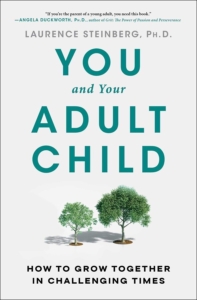 skimmed pages and jotted notes.
skimmed pages and jotted notes.
I started my full-time, tenure-track job the year Annie and Pearl began kindergarten. The following June, we adopted Emma. (At that point, friends did tell me I had lost my mind. They weren’t wrong.)
Maybe I need to write a “real” essay about all of this. Maybe I can stop scribbling for now.
It was a wild ride — I didn’t even get to the teenage years, did I? I’m sometimes upset that my daughters turned out so “different” from me, their values, their passions — not a poem in sight! I have been known to threaten moving to a stone cottage on the west coast of Ireland and throwing away my cell phone. But they keep coming around, they keep talking to me, and I keep being (unreasonably) happy when they do. I spoke with my pastor recently about some upsetting thing or other, and he recommended that I read You and Your Adult Child. He was reading it, he disclosed, “And it’s helping.” Finding other parents (writers, especially) has turned out to be crucial.
This morning I decided to reread Rose Cook’s poems (I’m lending the book to a friend). And I found this poem:
On Bringing Up Girls
Aren’t you going to clip her wings?
they said, That’s usual for a girl her age, isn’t it?
We said we didn’t want to clip her wings
and they watched our little daughter grow
bright and strong, then they saidAren’t you going to tie her feet? That’s
advisable for young girl, isn’t it?
We said we didn’t want to tie her feet,
so they saw a young woman growing
clear and brave. Before they could say anything else
we said, Now it is time to teach her to fly.
They fell back.They are teaching her to fly, they repeated,
teaching her to fly.
How wonderful, murmured their daughters,
and how interesting.— Rose Cook, from Notes from a Bright Field (Cultured Llama Publishing, 2013)
I once read this little meme — the girls were probably 12, 12, and 6 — that went, “If humans had wings, we’d consider flying to be exercise and never do it.” I read this aloud, and my daughter Pearl turned to me with wide eyes and said, “If I had wings, I would fly!”
And — in their way — I’m sure they do.
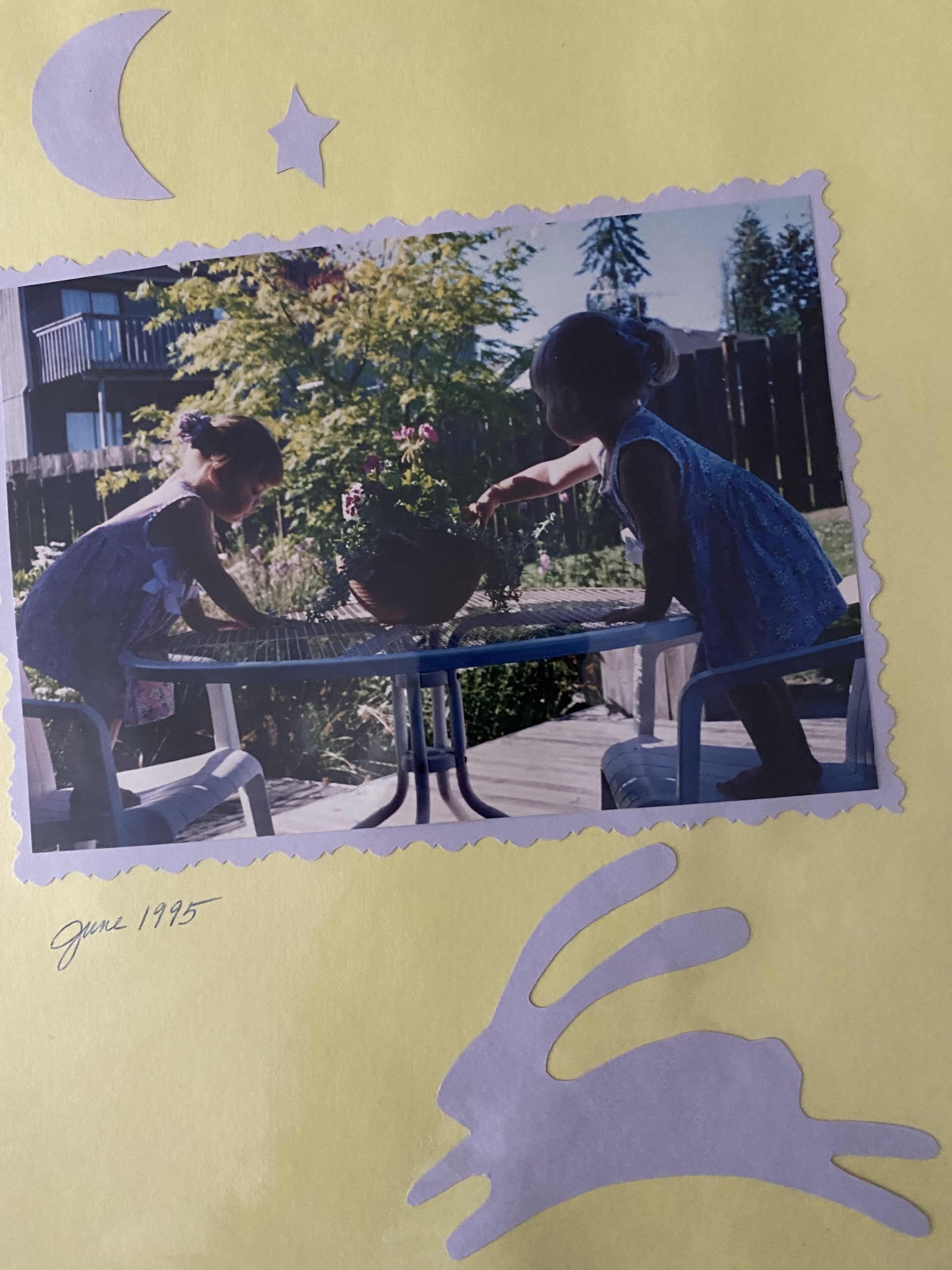
DESIRE’S AUTHORITY, J. I. Kleinberg, from Triple No. 23. Ravenna Press, Edmonds, Washington, 2023, pp. 61-80, paper, $12.95. http://ravennapress.com.
Last Saturday, I slipped away from the Chuckanut Writers Conference to attend a reading, at Dakota Art in downtown Bellingham, featuring Anita K. Boyle, Sheila Sondik, and J. I. Kleinberg. Yes, the conference was wonderful, with a plethora of good stuff on offer, but the trifecta of these voices, plus their art, was too great a temptation. I’m so glad I was able to be there.
Kleinberg read from several books, including her Dickinson inspired chapbook of collage poems, Desire’s Authority, published last year by Ravenna Press. I’ve been on a book-buying binge (a binge that seriously has to stop) but this book I already had in my possession. So, once I was home, I went through my TBR pile of poetry books and found it.
Take all the serendipity of how I stumbled into this happy accident, and times it by three, and you have Triple No. 23 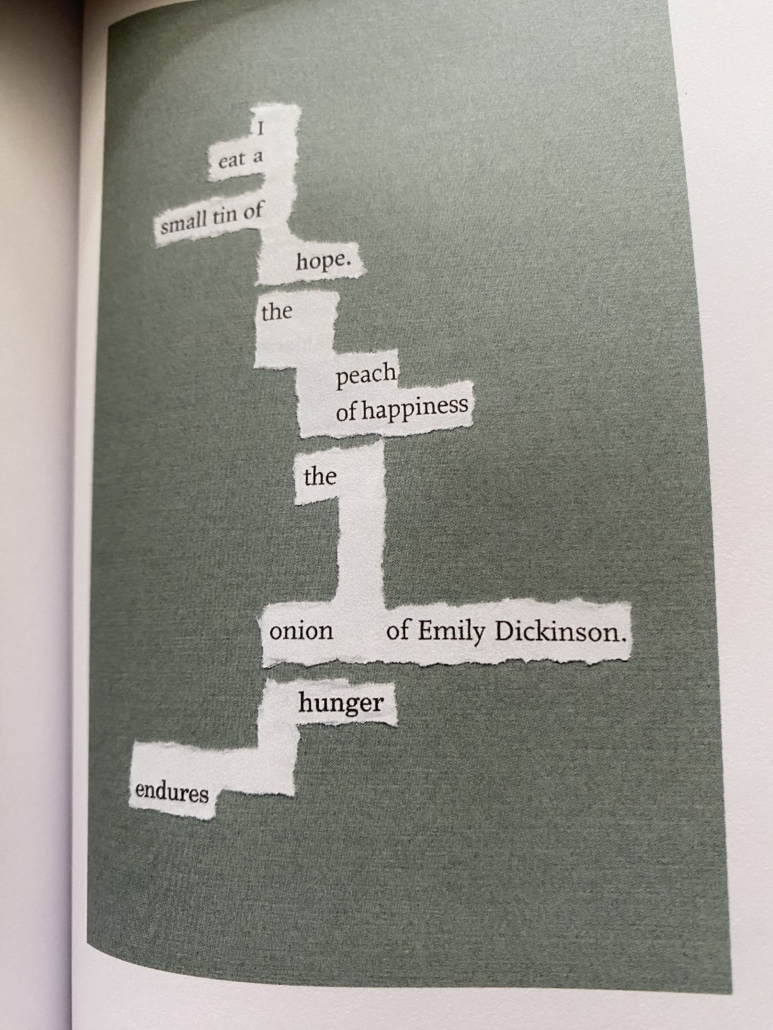 (also featuring chapbooks by Michelle Eames and Heikki Huotari).
(also featuring chapbooks by Michelle Eames and Heikki Huotari).
Kleinberg’s collage poems, alone, are all about serendipity, juxtaposition, and happy accidents. She creates them by cutting apart words found in magazines—if it sounds a bit like ransom demands, you’re not wrong. Not demanding in the sense of difficulty, but definitely willing to hold your attention hostage. In the author’s note Kleinberg reveals how she came up with her collage series (which is extensive, and not only this set of poems):
Through the accident of magazine page design, unrelated words fell into proximity to cast unintended meaning across the boundaries of sentence, paragraph, and column break. Leaving behind the words’ original sense and syntax, I collected these contiguous fragments of text, each roughly the equivalent of a poetic line. Arrayed on my worktable, they began to talk with one another and assume a new shape of visual poems. —J. I. Kleinberg (p. 89)
Gaps, fragments, the hop from one word or phrase to the next like hopping stone to stone across a creek, the occasional precarious drop—these found poems are a visual and poetic delight. I can’t decide on a water metaphor or fire to best describe them. Either way, I love these poems in part for how they invite a reader’s imagination into their creation. If there’s sometimes a little groping to find a shutter or door to throw open, a match to light, the illumination comes.
You can learn more about Kleinberg’s collage poems—and see examples—at her blog, Chocolate Is a Verb. She is also the curator of The Poetry Department, which delivers one poetry event, quotation, or other enticing poetry-related discovery every day.

borrowed from Judy’s blog, a photo from the exhibit, “Ink, Paper, Scissors: nature speaks in three voices”
![]()
HUSH, Rosemerry Wahtola Trommer. Middle Creek Publishing & Audio, 9167 Pueblo Mountain Park Road, Beulah, CO 81023, 2020, 110 pages, $20, middlecreekpublishing.com.
I am off to Bellingham, Washington, today for the Chuckanut Writers’ Conference, so I’m going to make this quick.
If your library does not already carry this book, urge them to acquire it!
I first came across Wahtola Trommer in the Poetry of Presence anthologies. Based on the evidence of those few poems, I decided I had to see a larger sampling. Along comes hush. And it lives up to its name. The poems are lullabies for a troubled spirit. They spell us into nature and soothe us into becoming cottonwood tree, becoming larkspur. “There is no way / to be anywhere but here,” we are reminded. But we are also reminded that we have some control over where we place our bodies.
Walking at Night
One way to open your eyes to unnoticed beauty is to ask yourself, “What if I had never seen this before? What if I knew I would never see it again?” —Rachel Carson, The Sense of WonderAnd so I memorize how it is
that the cheeks nearly freeze,
but the body’s so warm,
how the river informs every measure,
but the thoughts sift to silence,
how the body thrills
in its ability to swing one foot
in front of the other, how
walking is just another name
for recovering from falling,
how strange it seems now
that I was once afraid of the dark.—Rosemerry Wahtola Trommer
The epigraphs are a map to the poet’s influences—Carson, William Stafford, Shakespeare, Mary Oliver, Wendell Berry. Praise poems, lamentations, and invitations to healing that arrive “so soft that at first / you aren’t sure / it is raining / but the fragrance / overcomes you” (“Wish”).
In this weirdly busy season of my life (broken engagements, family dinners, an aging dog; political and international news insisting on attention alongside daughters’ road-trips and their cats needing to be fed; classes and readings and writing conferences) this book was a balm.
I read it twice.
Deciding to Sometimes Practice Being Snapdragon
All morning I make myself useful—
mow the lawn and vacuum
the carpet and scrub the potatoes
and slice the melon and straighten
the shelves and look out the window
and see the snapdragons I planted
last spring not because they were useful,
but because they are so beautiful.—Rosemerry Wahtola Trommer
Although a couple poems are more ambitious, while typing this poem I thought of a line from Jane Hirshfield’s Ten Windows about a similarly short, seemingly “small” poem: “The poem’s absence of punctuation is an open selvage as well, in place of what would ordinarily be finished seam.” In RWT’s case, it’s the near absence of punctuation; even so, this poem opened my imagination to further possibilities. Metonymic rather than metaphoric, it offers us a part that stands for the whole.
I also kept thinking of another favorite poet, Rose Cook, particularly “A Poem for Someone Who Is Juggling Her Life,” a line from which I have painted on a piece of board and hung on my wall (from Notes from a Bright Field, 2013): “Be still sometimes. / Be still sometimes. / Let it all fall sometimes.” In her own words, and out of the idiom of her own life, Wahtola Trommer offers this same advice.
 Although I have looked her up (and you can, too, beginning at Middle Creek Publishing, and her website, WordWoman, where you’ll find her other books, one of which I just ordered…), I’ll mention only this detail from author bio page at the back of hush:
Although I have looked her up (and you can, too, beginning at Middle Creek Publishing, and her website, WordWoman, where you’ll find her other books, one of which I just ordered…), I’ll mention only this detail from author bio page at the back of hush:
“Since 2006, she’s written a poem a day.”
So this blogpost wasn’t so quick after all. But is this a poet after my own heart, or what?
